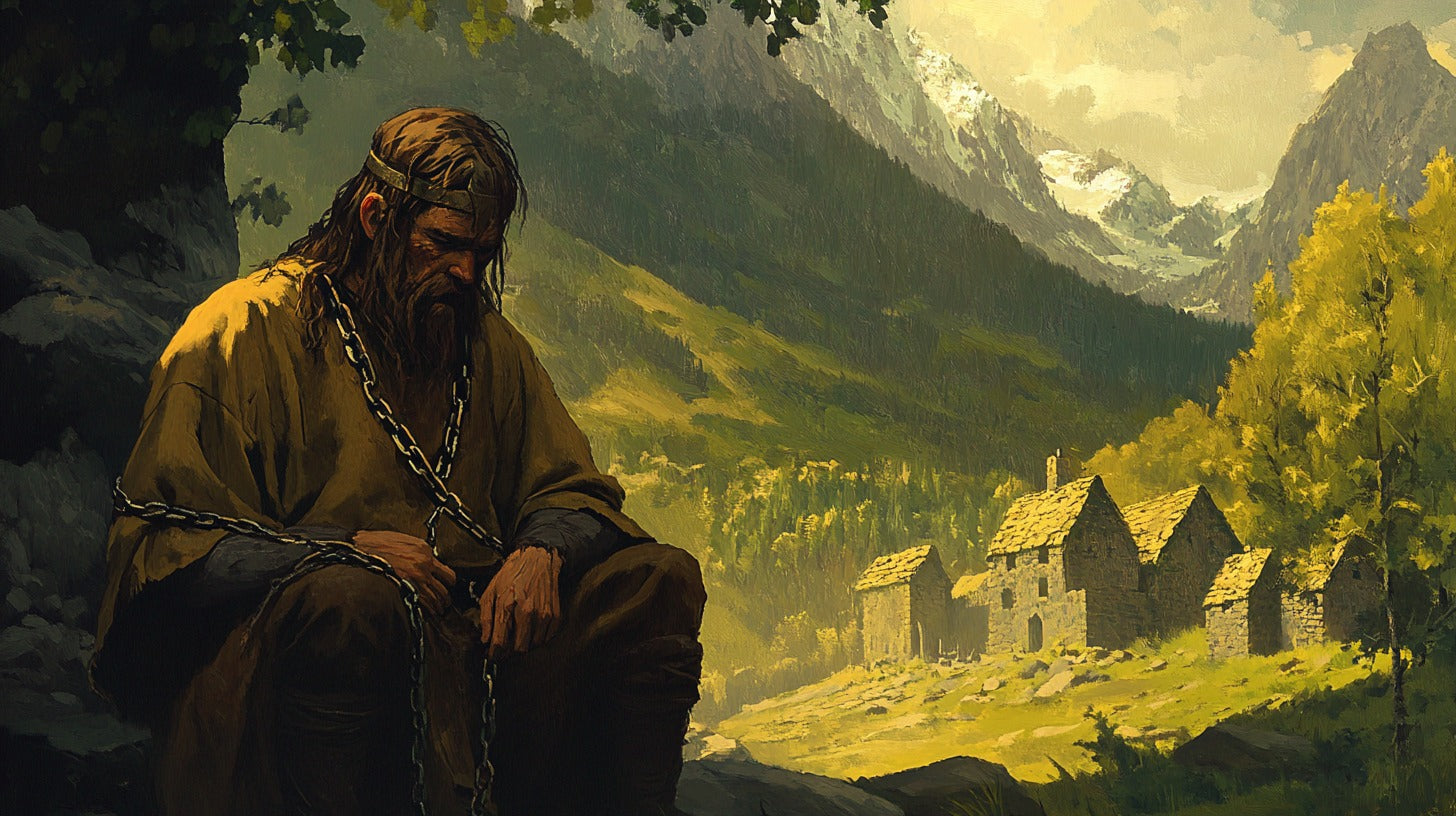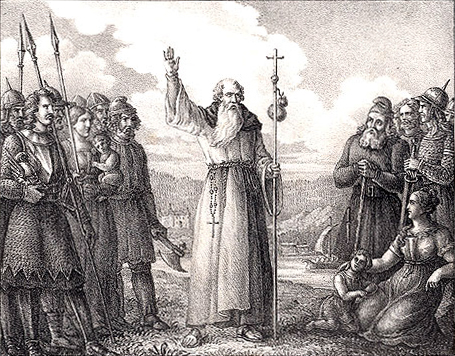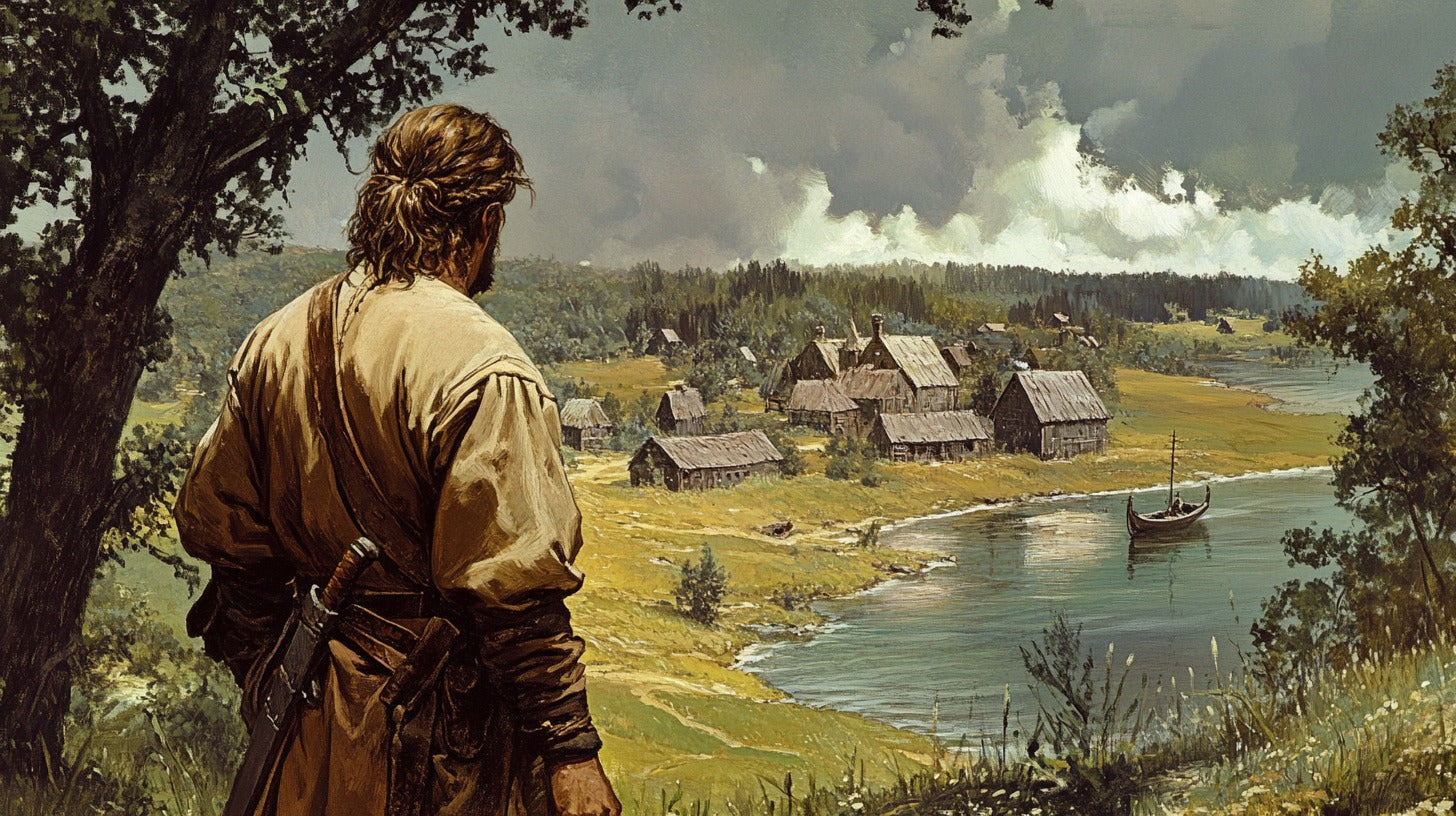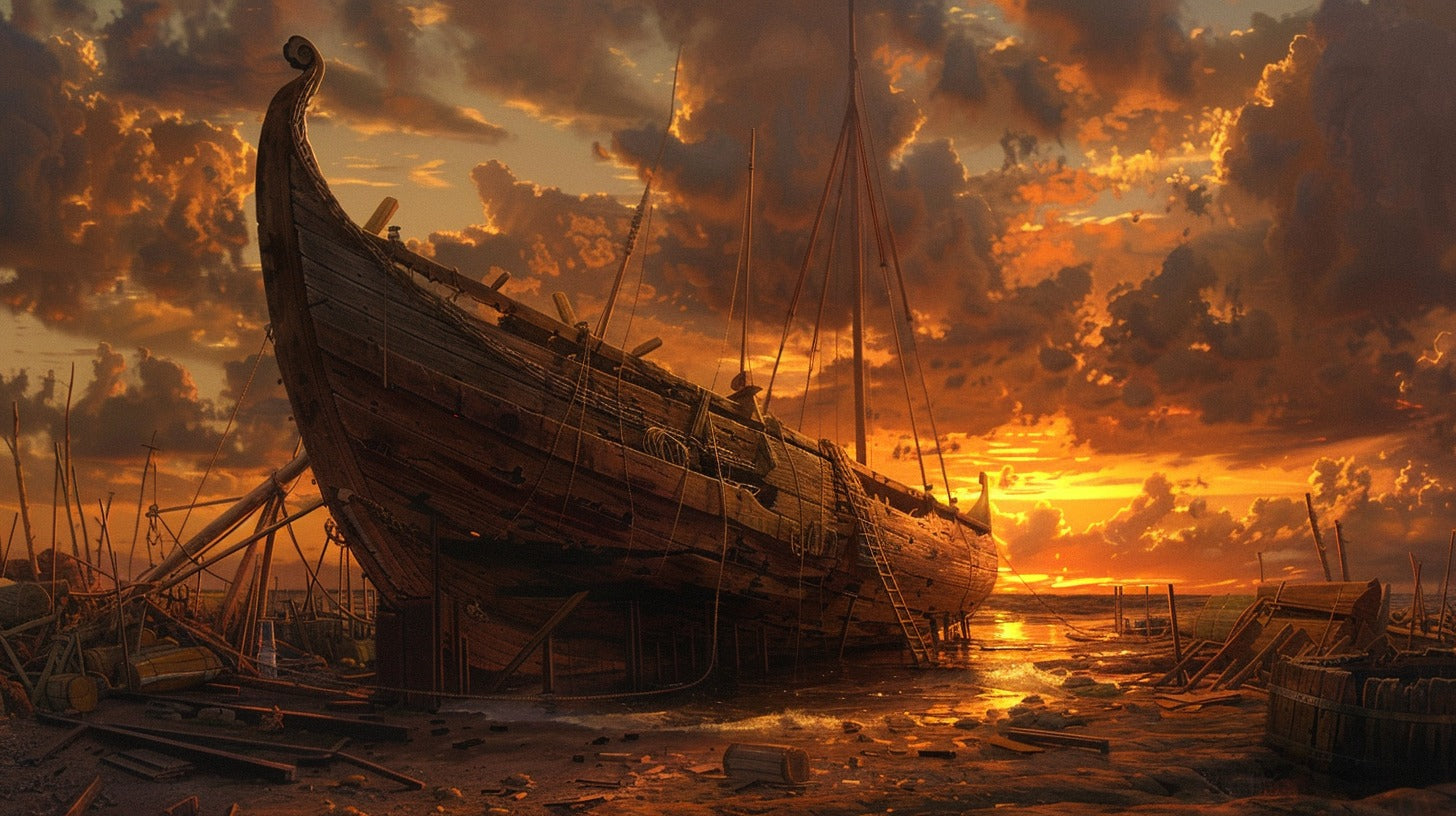
Chains of the North: The Untold Story of Viking Age Thralls
In the shadow of longhouses and beneath the thunder of Thor's hammer, a different kind of Norse story unfolds. It's not one of glory or adventure, but of servitude and survival. Welcome to the world of thralls - the slaves whose labor built the foundations of Viking society, and whose lives paint a vivid, often heartbreaking picture of life in the Norse world.
Origins and Definition of Thralls
Etymology and Meaning of "Thrall"
The word "thrall" echoes through time, a harsh whisper from a brutal past. Derived from the Old Norse "þræll," it paints a picture of bondage and servitude. But what did it truly mean to be a thrall in the world of fjords and frozen winters?
Sources of Thralldom in Norse Culture
Thralls weren't born; they were made. Some were captured in raids, torn from distant shores and brought to the cold North. Others fell into bondage through debt or crime, their freedom stripped away by the cruel hand of circumstance. And some, in the most bitter twist of fate, were born into thralldom, inheriting their parents' chains.
The Social Status of Thralls

Legal Rights (or Lack Thereof)
In the eyes of Norse law, thralls were less than human. They were property, no more afforded rights than a horse or a hammer. Their lives hung by a thread, subject to the whims of their masters. Yet, even in this darkness, glimmers of protection sometimes shone through, often more for the benefit of the owner than the owned.
Treatment and Living Conditions
Picture a thrall's life: backbreaking labor from dawn to dusk, meager meals, and nights spent in cramped, smoky quarters. Some masters treated their thralls with a measure of kindness, recognizing their value. Others reveled in cruelty, their treatment a stark reminder of the thrall's place at the bottom of Norse society.
Roles and Responsibilities of Thralls

Domestic Duties
Within the walls of Norse households, thralls moved like shadows. They cooked, cleaned, and cared for children. Their hands wove the fabric of daily life, even as their own lives unraveled in servitude.
Agricultural Labor
Beyond the homestead, in fields kissed by the brief Nordic summer, thralls toiled endlessly. They sowed, they reaped, they tended to livestock. The bounty of the land came at the cost of their sweat and blood.
Specialized Skills and Crafts
Not all thralls were condemned to unskilled labor. Some, by chance or design, became skilled artisans. These thralls - blacksmiths, jewelers, or shipwrights - held a precarious position, their skills both a blessing and a curse in their bounded existence.
The Economics of Thralldom
Thralls as Property
In the ledgers of Norse society, thralls were assets to be counted alongside silver and cattle. Their worth was measured not in the content of their character, but in the strength of their backs and the skills of their hands.
Trade and Value of Thralls
The thrall markets were places of heartbreak and horror. Here, human lives were bartered and sold, their value fluctuating like any other commodity. A strong man might fetch a high price, while the old or infirm could be cast aside like broken tools.
Family Life and Relationships
Marriage and Children
Even in bondage, the human heart yearns for connection. Thralls formed relationships, married, and had children. But these unions were fragile, subject to the whims of their masters. A family could be torn apart at a moment's notice, sold off to different owners without a second thought.
Kinship and Community Among Thralls
In the shared misery of their condition, thralls forged bonds of kinship. They created their own communities within the larger Norse society, finding solace and strength in their shared experiences.
The Path to Freedom

Manumission and Its Conditions
Freedom was a distant dream for most thralls, but not an impossible one. Some masters granted manumission as a reward for loyal service. Others allowed thralls to purchase their freedom, a monumental task that could take a lifetime of saving and sacrifice.
Integration of Freed Thralls into Society
For those who tasted freedom, a new challenge awaited. How does one integrate into a society that once saw them as property? Freed thralls walked a tightrope between their past and their future, striving to find their place in the complex social hierarchy of Norse culture.
Thralls in Norse Mythology and Literature
Representations in Sagas
The sagas, those great tales of Norse legend, didn't ignore the existence of thralls. They appear in these stories, sometimes as background characters, other times playing pivotal roles. Their portrayals offer us a window into how Norse society viewed these lowest of the low.
Thralls in Norse Cosmology
Even the gods had their thralls. In the great cosmic mill of Norse mythology, giants captured in divine wars were forced to turn the world-mill. This celestial echo of earthly thralldom speaks volumes about how deeply ingrained the concept was in Norse thinking.
The Psychological Impact of Thralldom
Coping Mechanisms and Resistance
How does the human spirit endure such bondage? Thralls developed various ways to cope with their harsh reality. Some found solace in small acts of defiance, others in the practice of their native religions. Rare, but not unheard of, were outright rebellions - desperate bids for freedom that often ended in tragedy.
Cultural Assimilation and Identity
Over time, many thralls, especially those born into bondage, began to assimilate into Norse culture. They learned the language, adopted the customs, and in some cases, even embraced the gods of their masters. Yet, this assimilation came at the cost of their original identities, a price paid in the currency of survival.
The Decline of Thralldom

Illustration by Hugo Hamilton
Influence of Christianity
As the cross began to cast its shadow over the Norse world, attitudes towards thralldom slowly shifted. Christian teachings, while not outright condemning slavery, introduced new ideas about human worth and dignity that would eventually contribute to thralldom's decline.
Economic and Social Shifts
The great Viking Age, with its raids and influx of captives, couldn't last forever. As Norse society evolved, becoming more settled and feudal, the economic foundations of thralldom began to crumble. Gradually, thralls were replaced by tenant farmers and paid laborers.
Legacy and Historical Significance
The institution of thralldom left an indelible mark on Norse society and beyond. Its echoes can be heard in language, in social structures, and in the complex tapestry of Scandinavian history. Understanding thralldom is crucial to comprehending the full picture of Viking Age culture, in all its complexity and contradiction.
Conclusion
The story of thralls in Old Norse society is not a pleasant one. It's a tale of human suffering, of lives spent in bondage, of families torn apart, and of dreams deferred. Yet it's also a testament to human resilience, to the enduring spirit that can find hope even in the darkest of circumstances. As we look back on this aspect of Norse history, we're reminded of the complex, often brutal realities that underpin even the most romanticized historical periods. The thralls' story is one that deserves to be told, a crucial piece in understanding the full tapestry of Viking Age Scandinavia.
FAQs
- Were all thralls in Norse society captured in raids?
No, while many thralls were indeed captured during Viking raids, others became thralls due to debt, as punishment for crimes, or were born into thralldom.
- Could thralls ever gain their freedom?
Yes, thralls could be freed through a process called manumission. This could be granted by their masters or, in some cases, thralls could save money to buy their freedom.
- How did Norse law view thralls?
In Norse law, thralls were generally considered property rather than people. They had very few, if any, legal rights of their own.
- Did thralldom exist throughout the entire Viking Age?
Thralldom was a significant part of Norse society throughout most of the Viking Age, but it began to decline towards the end of this period, influenced by economic changes and the spread of Christianity.
- Were there any famous thralls in Norse history or mythology?
While individual thralls rarely achieved fame, there are some notable exceptions in Norse mythology. For example, the goddess Skadi's father, Thjazi, was said to have thralls who turned the world-mill.
References
Karras, R. M. (1988). Slavery and Society in Medieval Scandinavia. Yale University Press.
Brink, S., & Price, N. (Eds.). (2008). The Viking World. Routledge.
Winroth, A. (2014). The Age of the Vikings. Princeton University Press.
Roesdahl, E. (1998). The Vikings. Penguin Books.
Jochens, J. (1995). Women in Old Norse Society. Cornell University Press.







